Palm Leaves Turning Black | Black Spots Causes & Treatments
Fungal infections and overwatering are the main reasons for black spots on palm leaves. To treat black spots, it is important to prune the damaged leaves, use fungicide and fix the watering schedule.
Black spots on palm fronds are a common issue that can have a significant impact on the health and appearance of the trees. It is important to address this issue as soon as possible to prevent the spread of the disease and avoid further damage to the palm tree.
One of the primary causes of black spots on palm tree leaves is a fungal infection, which happens due to a number of reasons such as poor drainage, over-watering, and humid conditions.
Other potential causes of palm leaves having black spots include nutrient deficiencies, insect infestations, and environmental problems.
Remedies for black spots on palm fronds include cultural controls such as proper watering and fertilization practices, as well as fungicides to address the fungal infection.
It is important to consult with a professional arborist or horticulturist to accurately diagnose the issue and determine the best course of action for treatment.
Regular maintenance and monitoring of palm trees can also help prevent this problem further.
Palm Leaves Turning Black – What Causes It?
Palm trees can be susceptible to a variety of diseases and pests that can damage their leaves and overall health. One common issue that palm tree owners may face is the development of black spots on the leaves, which can be caused by a variety of factors.
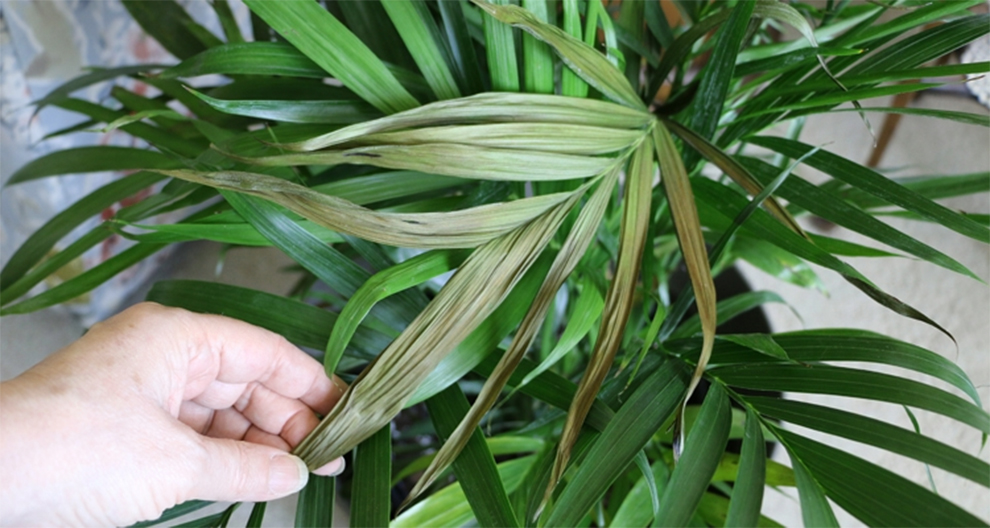
Here are some of the most common causes:
1. Fungal infections: Fungal infections are one of the primary causes of black spots on palm tree fronds. These infections can be caused by a variety of fungal pathogens.
The genus Pestalotiopsis is responsible for these black spots that typically thrive in warm, humid conditions and can spread rapidly if left untreated, leading to severe damage to the palm tree.
The infections are often spread by wind or rain and can quickly spread to other leaves if not addressed.
2. Bacterial infections: Bacterial infections such as lethal bronzing, Fusarium wilt, Xanthomonas leaf spot, and Erwinia blight can lead to the wilting and yellowing of the leaves, as well as the development of black spots.
Some of these infections can be quite serious and even lethal to the palm tree.
3. Nutrient deficiencies: Deficiencies in essential nutrients such as magnesium, potassium, or calcium can cause black spots to appear on palm tree leaves, as well as other symptoms such as yellowing, stunted growth, and leaf drop.
4. Overwatering: Overwatering can cause black spots on palm tree leaves. When palm trees are overwatered, it can lead to waterlogged soil and poor drainage, which creates ideal conditions for fungal growth. Fungal infections can cause black spots to form on the leaves.
5. Insect damage: Insects such as spider mites or scale insects can weaken the palm tree, making it more susceptible to fungal infections that can cause black spots on the leaves.
In addition to weakening the palm tree, some insects may also cause physical damage to the leaves, which can create openings for fungal pathogens to enter and cause black spots to form.
6. Environmental stress: Environmental stressors such as extreme temperatures or exposure to harsh chemicals can weaken the palm tree’s immune system and make it more susceptible to disease.
Proper care and maintenance of palm trees, including regular inspection for signs of disease or stress, can help prevent further damage.
If black spots are detected, appropriate measures should be taken to address the underlying cause and prevent the further spread of the disease.
What Do Black Spots on Palm Leaves Look Like?
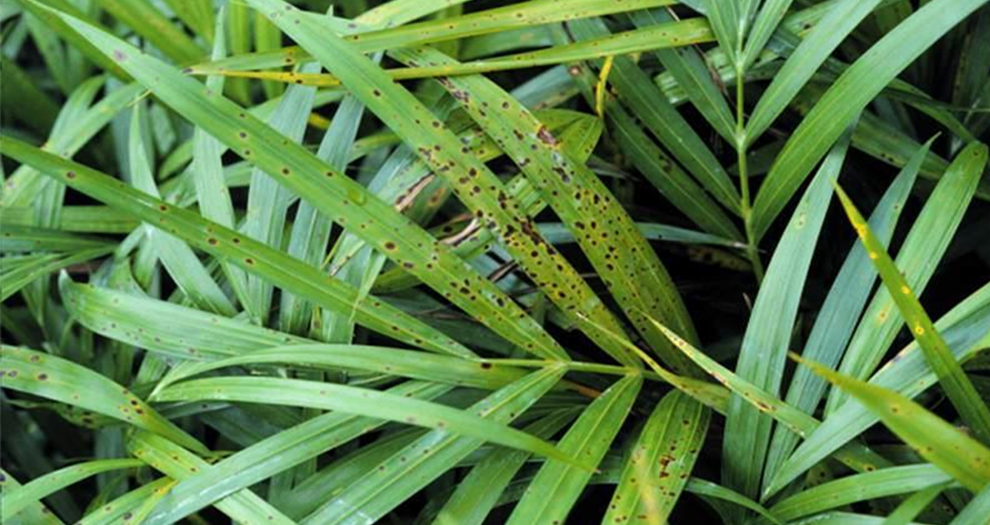
Black spots on palm tree fronds typically appear as circular or irregular-shaped lesions that are dark brown or black. The spots can range in size from specks to larger patches, and they may be raised or sunken in appearance.
The texture of the spots may vary depending on the underlying cause, but they can be rough or smooth to the touch.
If the black spots are caused by a fungal infection, they may spread rapidly to other leaves on the plant. In some cases, the spots may merge and form larger patches of discoloration. However, if the spots are caused by a nutrient deficiency, they may remain localized to the affected leaves.
As the disease progresses, the affected leaves may start to yellow or brown, and the leaf tissue may become necrotic (dead).
In severe cases, the affected leaves may drop from the plant. If the underlying cause of the black spots is not addressed, the disease can continue to spread and lead to the eventual death of the palm plant.
Early detection and intervention can help prevent the spread of the disease and preserve the health and appearance of the palm plant.
Regular inspection of palm leaves for the presence of black spots and other signs of disease is recommended, and appropriate measures should be taken to address any issues as soon as they are detected.
How To Prevent Black Spots on Palm Plants?
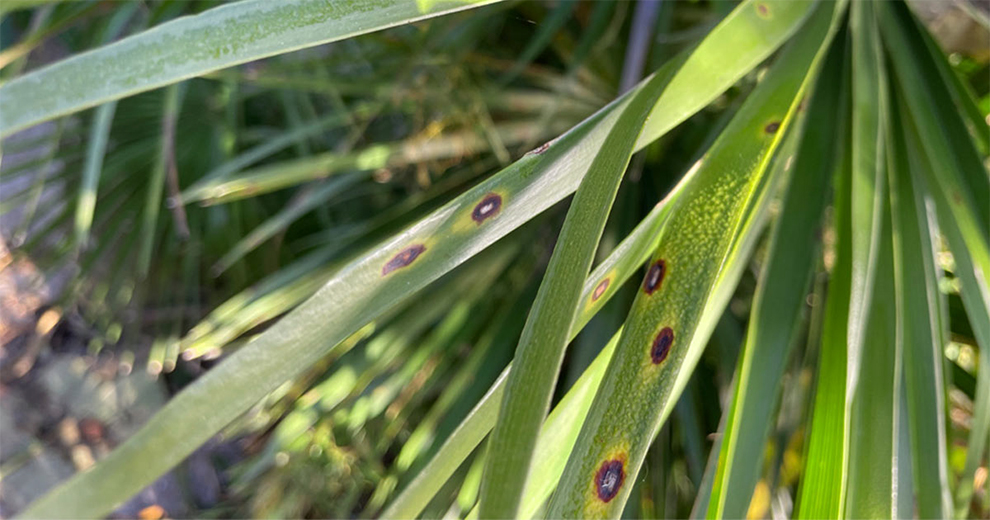
Black spots on palm fronds can damage the plant and cause unsightly blemishes. Early intervention can help prevent the spread of the disease and minimize the damage to the plant.
It can also help prevent other issues from arising, such as nutrient deficiencies, pests, or diseases and preserve the life of the plant.
Here are some tips for preventing black spots on palm fronds:
1. Proper watering: Overwatering or underwatering can stress the palm plant and make it more susceptible to disease. Make sure to water the palm appropriately based on its needs and the specific growing conditions.
It is generally recommended to water palm trees once or twice a week, depending on the soil type, drainage, and size of the tree. Water the palm trees slowly and deeply, so that the water reaches the roots.
Do not water the leaves directly, as it can promote fungal growth and cause black spots on the leaves. Adding a layer of mulch around the base of the tree can help retain moisture in the soil and reduce the frequency of watering.
However, be careful not to over-mulch, as it can lead to overwatering and root rot.
2. Adequate drainage: Make sure that the soil has adequate drainage to prevent water from pooling around the roots, which can cause root rot and other issues. Use well-draining soil and avoid planting in heavy clay soils that retain moisture.
3. Proper fertilization:
Make sure to provide the palm with appropriate fertilization based on its specific nutrient needs. To address nutrient deficiencies, it is important to ensure that the palm tree is receiving adequate amounts of the necessary nutrients.
This can be achieved through regular fertilization, either through slow-release fertilizers or through periodic applications of liquid or granular fertilizers.
Over-fertilization can lead to nutrient imbalances and other issues. It is also important to monitor the pH of the soil, as nutrient availability can be affected by soil pH. A soil test can help identify any nutrient deficiencies and guide appropriate fertilization practices.
4. Pruning
Pruning is an important maintenance practice that can help prevent black spots on thw palm. Prune off any dead or damaged fronds, as they can provide a breeding ground for pests and diseases, including the fungi that cause palm tree leaves turning black.
Clean up fallen leaves and debris as they can also spread the disease. Prune palm trees in the late winter or early spring, before new growth begins. Avoid pruning during the summer months, as it can stress the tree.
Over-pruning can stress the palm tree and make it more susceptible to diseases. Only remove fronds that are dead, yellow, or brown.
5. Pest management
Keep an eye out for any signs of pest infestations, such as spider mites or mealybugs. To prevent insect damage and the associated risk of fungal infections, it is important to monitor palm trees regularly.
Look for signs of insect infestations and to take appropriate measures to control them if necessary.
This may involve using insecticides, pruning affected areas of the tree, or introducing natural predators of the insect pests.
6. Proper lighting: Palm trees need plenty of sunlight to thrive. Insufficient or excess light can cause stress and make the plant more susceptible to disease. They typically require at least 6 hours of direct sunlight each day.
While palm trees need sunlight, they can be sensitive to direct sunlight, especially in hot climates. Direct sunlight can cause the leaves to burn, which can create wounds that are susceptible to infection.
If your palm tree is located in an area with intense sunlight, consider using shade cloth to protect the tree. If your palm tree is located in an area with low light levels, you can use artificial lighting to provide the right amount of light.
7. Proper spacing: Check the specific spacing requirements for the species of palm you are growing. Palm trees can grow to be quite large, so it’s important to consider the mature size when spacing them.
Leave enough space between trees so that they have room to grow without touching each other. Good air circulation can also help prevent the spread of fungal spores that can lead to black spot disease. Avoid planting too many palm trees in a small area.
8. Clean tools
Use clean, sharp tools to make clean cuts, and avoid tearing or damaging the remaining fronds. Cut the frond stem close to the trunk, leaving a small stub.
Disinfect pruning tools between cuts to prevent the spread of diseases. You can use rubbing alcohol or a mixture of 1 part bleach to 9 parts water.
By providing appropriate growing conditions and practicing good plant care habits, you can help prevent black spots on your palms and promote healthy growth.
Related: White Spots on Palm | Brown Spots on Palm | How to Know If Your Palm Tree Is Dying| Kentia Palm Turning Brown
How To Treat Black Spots On Palm Plants?
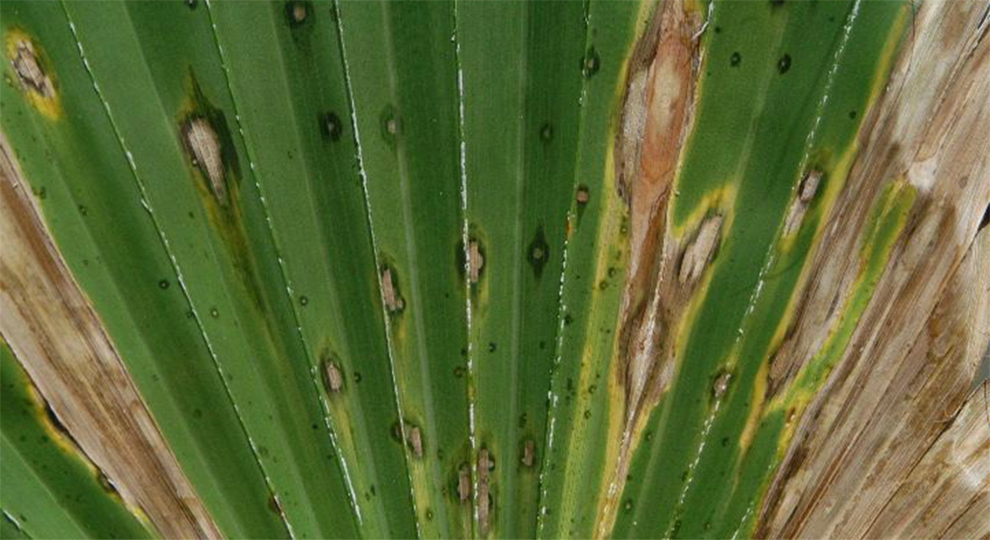
Black spots on palm fronds can be a sign of a fungal or bacterial disease, or they could be caused by environmental factors such as nutrient deficiencies, water stress, or insect damage. Here are some steps you can take to treat black spots on your palms:
1. Determine the underlying root cause: Before you begin treatment, it’s important to identify the cause of the black spots. You can do this by examining the leaves and looking for other symptoms such as yellowing, wilting, or curling.
2. Remove affected leaves: If the black spots are widespread, you may need to remove the affected leaves. This can help prevent the spread of the disease to other parts of the plant.
3. Improve growing conditions: Ensure that the palm is receiving enough water, sunlight, and nutrients to support its growth. Make sure that the soil is well-drained, and avoid overwatering.
4. Apply fungicides and bactericides
If the black spots are caused by a fungal disease, you can apply a fungicide to the affected leaves. Follow the instructions on the label carefully.
5. Apply insecticide
If the black spots are caused by insect damage, you can apply an insecticide to the affected leaves.
6. Monitor the plant: Keep an eye on the palm and continue to monitor it for any signs of disease or pests. If the black spots persist or spread, you may need to take additional steps or seek professional help to address the problem.
It’s important to note that prevention is often the best approach when it comes to managing palm leaves turning black. Make sure to keep your palm healthy by providing it with proper care, and address any issues promptly to prevent them from becoming more serious.
